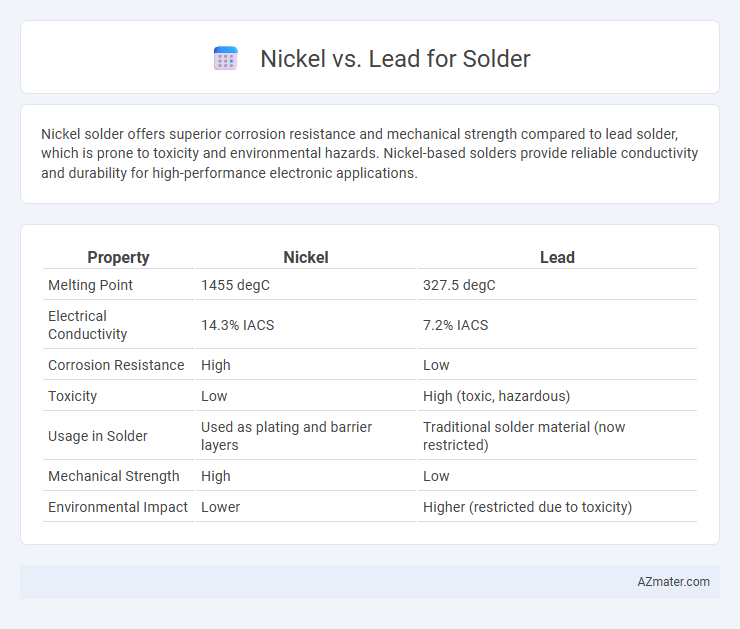Nickel solder offers superior corrosion resistance and mechanical strength compared to lead solder, which is prone to toxicity and environmental hazards. Nickel-based solders provide reliable conductivity and durability for high-performance electronic applications.
Table of Comparison
| Property | Nickel | Lead |
|---|---|---|
| Melting Point | 1455 degC | 327.5 degC |
| Electrical Conductivity | 14.3% IACS | 7.2% IACS |
| Corrosion Resistance | High | Low |
| Toxicity | Low | High (toxic, hazardous) |
| Usage in Solder | Used as plating and barrier layers | Traditional solder material (now restricted) |
| Mechanical Strength | High | Low |
| Environmental Impact | Lower | Higher (restricted due to toxicity) |
Introduction to Soldering Materials
Nickel and lead serve distinct roles as soldering materials, with nickel often used as a plating layer to enhance solderability and corrosion resistance, while lead has traditionally been a common element in solder alloys due to its low melting point and excellent wetting properties. Lead-based solders, primarily composed of tin and lead, provide ease of flow and mechanical strength but face restrictions due to health and environmental concerns. Nickel-based soldering finishes, such as electroless nickel immersion gold (ENIG), offer superior durability, oxidation resistance, and compatibility with lead-free solder alloys, making them essential in modern electronics manufacturing.
Overview of Nickel and Lead in Solder
Nickel in solder provides enhanced mechanical strength, corrosion resistance, and higher melting points, making it ideal for demanding electronic applications and high-reliability environments. Lead, historically common in solder alloys like SnPb, offers excellent wetting properties and low melting temperatures but poses significant health and environmental risks, leading to widespread regulatory restrictions. Modern solder formulations increasingly favor lead-free options with nickel to meet safety standards while maintaining performance.
Physical Properties: Nickel vs Lead
Nickel exhibits higher melting point (1455degC) compared to lead (327.5degC), offering superior thermal resistance in solder joints. Nickel's greater tensile strength and hardness enhance durability, whereas lead provides better malleability and ease of shaping. Corrosion resistance is notably higher in nickel, making it more suitable for applications requiring long-term stability and reliability.
Electrical Conductivity Comparison
Nickel exhibits significantly lower electrical conductivity compared to lead, with nickel's conductivity around 14% IACS (International Annealed Copper Standard) and lead's approximately 7%. While nickel provides better mechanical strength and corrosion resistance, lead-based solder typically offers superior electrical conductivity, crucial for efficient electron flow in electronic connections. Selecting solder materials requires balancing conductivity with factors such as environmental impact and mechanical robustness.
Melting Point Differences
Nickel has a melting point of approximately 1455degC, significantly higher than lead's melting point of 327.5degC, making nickel-based solders more suitable for high-temperature applications. Lead solder melts at a much lower temperature, typically around 183degC for eutectic compositions, allowing easier soldering but limiting thermal resistance. The substantial melting point difference influences the choice between nickel and lead solder in electronics, with nickel preferred for durability and lead for low-temperature assembly.
Corrosion Resistance and Longevity
Nickel solder offers superior corrosion resistance compared to lead solder, making it ideal for applications exposed to harsh environments or moisture. The dense, passivating oxide layer of nickel prevents oxidation and degradation, significantly extending the longevity of solder joints. Lead solder, while easier to work with, corrodes more quickly and is prone to fatigue failure over time, reducing the overall durability of electronic assemblies.
Health and Environmental Impact
Nickel-based solder poses less risk of lead poisoning, which is a significant health concern with lead solder due to its neurotoxic effects, especially in children and pregnant women. Environmentally, lead solder contributes to soil and water contamination through improper disposal, while nickel solder reduces hazardous waste but may cause allergic skin reactions in sensitive individuals. Choosing nickel solder supports safer manufacturing practices and complies with regulations like RoHS, minimizing toxic metal exposure and environmental damage.
Application Suitability in Electronics
Nickel and lead differ significantly in electronics soldering, with nickel often used as a plating material due to its excellent corrosion resistance and strong adhesion properties, making it ideal for connector finishes and protecting underlying metals. Lead-based solders, traditionally preferred for their low melting point and ease of use, face restrictions due to toxicity concerns and RoHS compliance, limiting their application in modern electronics. Nickel's compatibility with lead-free solders such as SAC alloys (tin-silver-copper) supports environmentally friendly, reliable joints essential for high-performance electronic devices.
Cost Analysis: Nickel vs Lead Solder
Nickel solder typically costs more than lead solder due to higher raw material prices and more complex manufacturing processes. Lead solder remains cheaper but faces increasing regulatory restrictions, which may lead to future price volatility. The total cost of ownership for nickel solder can be lower in the long term due to better durability and compliance with environmental standards.
Conclusion: Choosing the Right Solder
Nickel solder offers superior corrosion resistance, higher melting points, and better mechanical strength compared to lead solder, making it suitable for high-reliability and high-temperature applications. Lead solder, while easier to work with due to its lower melting point and excellent wetting properties, poses health and environmental risks due to its toxicity. Choosing the right solder depends on application requirements, regulatory compliance, and long-term durability, with nickel-based solders preferred in electronics demanding robust performance and lead-free mandates.

Infographic: Nickel vs Lead for Solder
 azmater.com
azmater.com